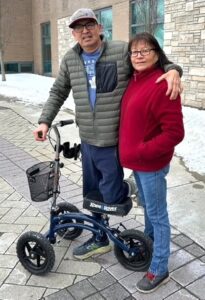Former Mississauga #8 First Nation Chief raising awareness on diabetes management

By Rick Garrick
MISSISSAUGA #8 FIRST NATION — Former Mississauga #8 First Nation Chief Bob Chiblow is raising awareness of the need to take diabetes more seriously with his cautionary tale after almost losing his foot due to diabetes-related complications.
“I had an issue with my foot a couple of years ago — my sugar was high and I wasn’t taking my pills,” Chiblow says. “I ended up getting a wound and it got infected to a point where there was some dead tissue.”
Chiblow says the dead tissue was cut out and his foot healed back then.
“When I went to meet the King two summers ago, I was in a walking cast for that first injury,” Chiblow says. “That healed, [but] I was favouring that particular thing and kind of walking on the side of my foot. Then that actually got injured and still my sugars really weren’t under control, they were getting better because I was taking pills and I was trying to maintain a good diet.”
Chiblow says his foot then got infected last fall just before the end of October.
“I should have been staying off it like the doctor ordered,” Chiblow says. “My foot was starting to get red and sore, and I was getting the chills. My wife encouraged me to go to the hospital to get [my foot] checked out.”
Chiblow says he was treated with antibiotics for the infection.
“They ended up being unable to treat me in Blind River here,” Chiblow says, noting that his wife drove him to the hospital in Sault Ste. Marie on Nov. 1. “It was pretty close to being [amputated], that’s how bad it was.”
Chiblow says the infection was cut out of his foot and he was kept in the hospital in Sault Ste. Marie until Jan. 9.
“They just patched that big opening with gauze for a couple of days until [Nov.] 4,” Chiblow says. “The wound care nurse … decided the best thing would be to put a VAC (vacuum-assisted closure) dressing on. There’s a vacuum pressure put on the wound that actually sucks out any drainage and it promotes the growing of the tissue.”
Chiblow says he received care for his wound dressing from a home care nurse after being released from the hospital.
“It was healing nice and then probably about three weeks ago, maybe four weeks ago it started getting infected again,” Chiblow says. “We went right to the hospital, they gave me antibiotics again, we went to the Sault again, and the doctor just kind of cleaned out some of that stuff and put me on Penicillin. It kind of all grew in and healed.”
Chiblow says he has started to take his diabetes medication now.
“I started taking the shots of insulin, which allowed my body to keep my sugars down, which again promoted the blood flow to the foot,” Chiblow says. “So it took me almost losing my foot to actually listen to the doctor’s orders.”
Chiblow says he is no longer able to stay on his foot for more than an hour.
“The doctor told me if you’re on it for an hour, you’ve got to stay off it for half an hour,” Chiblow says. “I said, ‘How long does that got to be?’ He goes, ‘Forever.’”
Chiblow says he was provided with a proper diet for diabetes and began taking insulin while he was in the hospital.
“So my sugar normalized,” Chiblow says. “Being in the hospital taught me a good diet, now I’m hooked on cottage cheese and fruit cups — that’s what I have every night, and yogourt.”
Chiblow says he also has an knee scooter, which has a handle bar and a pad to put his knee on, to use when he is going to places such as shopping malls.
“We bring it everywhere we go,” Chiblow says. “Instead of just walking and trying to hobble around, we pulled out the knee scooter and I was scooting around.”

